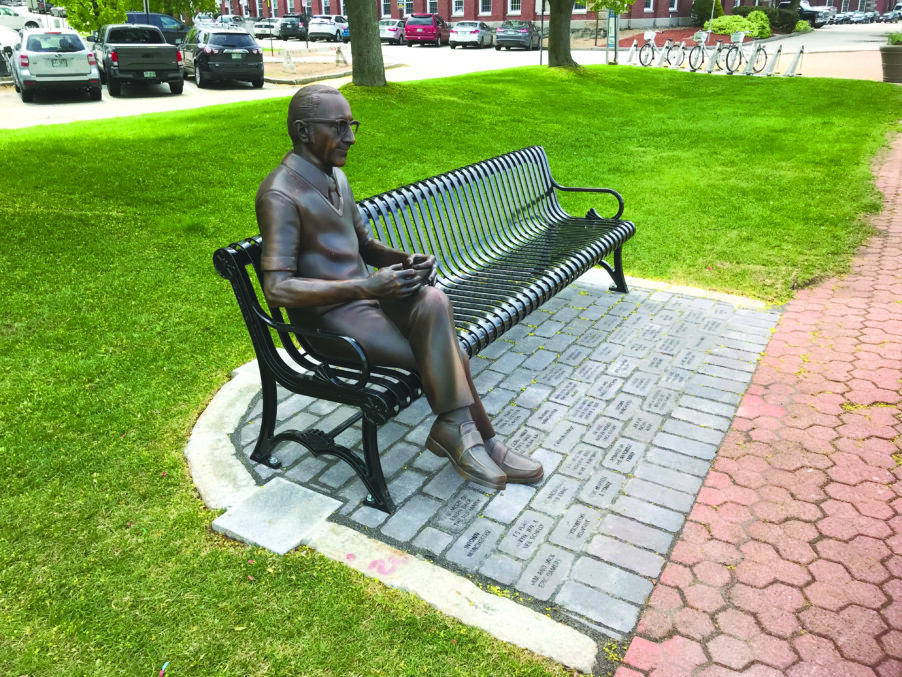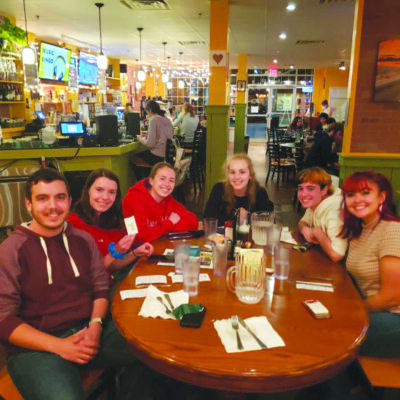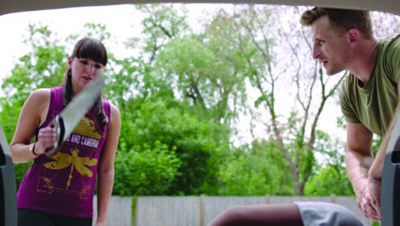Mini parks, lesser-known monuments, land trusts and other unexpected outdoor spaces
Rocks that rock
On the hunt for rocks with history
By Dan Szczesny
The following is an excerpt from NH Rocks That Rock: An Adventure Guide to Twenty-Five Famous Boulders in the Granite State by Dan Szczesny and his daughter Uma (2021, Hobblebush Books). See danszczesny.com, where you can purchase this and other books by Dan and find information on upcoming events.
New Hampshire loves its rocks. Though the state’s nickname, The Granite State, actually comes from a preponderance of 19th-century quarries, the casual visitor wouldn’t know it from how many famous, historic, named or identified rocks and boulders there are all across the state.
From the ocean to the south, to the river valley to the west to the grand White Mountains up north, the state is full of boulders with eccentric names such as the Old Man of the Valley, Nessie’s Humps, Big Bertha, T-Rex, Boise Rock, Glen Boulder and The BOB, just to name a few. There are Elephant, Dog, Frog, Sheep, Monkey and Wolf rocks. Take a ferry to the Isles of Shoals for Underhill’s Chair. And take a moment to puzzle out the state’s greatest love story, the Chicken Farmer I Still Love You Rock.
Some are boulders. Some are glacial erratics. Some are cleaved from cliffs and mountain walls. Others just happened to be in places of historic importance and have been labeled through time. Some are monuments to people or events. A few have signs, while many you’ll have to search for. Some are brand new. A few have been on the New Hampshire map since before New Hampshire was New Hampshire.
One weighs more than 5,000 tons and is one of the largest glacial erratics in North America. You can’t miss Madison Boulder.
During a short hike out to Frog Rock in New Boston, my 6-year-old daughter asked me what other rocks were named after animals.
A lot, it turns out. Oh, so very many!
So the idea for our field guide, hiking patch quest and certificate was born.
Chicken Farmer Rock, Newbury
Access: Right on the north side of Route 103 about two miles south of Newbury town center. Nearest address is 539 Route 103.
Of all the rocks in New Hampshire, all the great stone profiles, all the epic gravity-defying boulders and grand vista-facing cliffs, one rock stands above them all in popularity and fame.
We are, of course, talking about the Chicken Farmer I Still Love You Rock.
This painted, overgrown, weedy outcropping along a busy state route is so well-known Google Maps has it pinned as a Historical Landmark. Even Madison Boulder doesn’t get that.
But that’s accurate because the Chicken Farmer I Still Love You Rock is all about history, and that history more or less encompasses what it’s like to be from and live in New Hampshire, where love stories about chicken farmers are entirely relatable.
In short, local legend tells the tale of a hard-working Chicken Farmer and his wife who lived across the road. So hard-working to provide for his family was this farmer that the wife became upset at him for spending so much time away from the family. She lashed out, but instantly regretted her anger. And realizing how grateful she was for her husband, she painted the words on the rock, “Chicken Farmer I Love You,” as a love note and apology.
Years later, in what was perhaps the greatest small town government mistake of all time, the message was covered, the town deeming it to be graffiti. Petitions were signed. Angry voices expressed outrage. And overnight, a new sign was painted, only this time the word “still”was added. And so it remains.
New Hampshire writer and storyteller Rebecca Rule said the original message and the update are two parts of the same message. “The original is a story of young love,” she said. “The revision is the story of unrequited and enduring love. Two beautiful stories; one rock.”
The chicken farmer endures.
The Train/Londonderry
Boulder, Londonderry
Access: We’re certain you’ve driven by The Train many times, as it sits on one of the busiest roads in one of the most densely populated areas, near Boston-Manchester Regional Airport. The rock, usually covered in graffiti, can be found jutting out of the embankment on Rockingham Road/Route 28 in North Londonderry near the intersection with Sanborn Road. If you’re heading south from Manchester, turn right on Sanborn Road and park in one of the office parking lots, then walk back. But of course be careful of traffic on this very busy road.
Of all the boulders on our list, The Train may have the richest pedigree as the slab that birthed the career of one of the best-known rock climbers in the world.
“I think I was maybe 14, driving back from soccer practice with my mom when I saw just one guy on that boulder,” said pro climber Joe Kinder. “I was obsessed with climbing but didn’t really have any outlets and I kept getting in trouble as a kid so my mom just stopped the car and told me to go say hi.”
Young Kinder hit the jackpot that day as the climber working the rock was none other than Brett Meyers, another pro most associated with developing routes on the Pawtuckaway Boulders.
Kinder already had a mentor at Manchester West High School, a guidance counselor named Gary Hunter, himself an amateur climber who encouraged Kinder to climb. But now, with a friendship with Meyers, Kinder’s destiny was set.
“Being from New England, it’s not easy to find the most profound places to climb,” Kinder told me from Las Vegas, where he now lives. “But that rock, in terms of rock quality, texture and accessibility, makes it special. It was like our little playground, a practice place where we could have fun and try new things. That place made me!”
Climb in the shadow of the greats, there on a busy state route in Londonderry.
Frog Rock, New Boston
Access: The rock that started it all. From Route 13 heading north through Mont Vernon go left on Francestown Turnpike, also known as 2nd New Hampshire Turnpike. Drive about 3 miles. The southern entrance to Frog Rock Road (now an abandoned access road) will be on your right, just after a long left turn with warning sign arrows. If you reach Hopkins Road, you’ve gone too far. Parking is available at the side of the road for perhaps two cars.
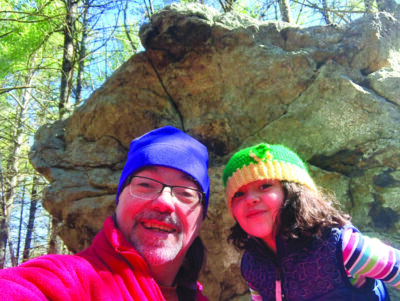
The dirt road path will reach some stone barriers at about 0.1 mile and a sign indicating that you are entering Frances Hildreth Townes Memorial Forest. Continue down the trail road for about 0.35 mile or so until you see a clear side path on your right. Take that 50 feet or so to Frog Rock.
It was Frog Rock that started it all. The list. The patch. The book you hold. Somewhere along the way, Little Bean wanted to find more rocks shaped like creatures. And once that door opened, there was no closing it.
And perhaps unlike many of the other rocks on this list, there’s very little debate over Frog Rock’s namesake. From a particular angle, the 10-foot erratic looks exactly like what it’s named after. So much so in fact that Frog Rock used to be a popular destination in the days of the grand hotels.
There were five grand (and grand-ish) hotels in the Mont Vernon area around the mid to late 19th century that drew tourists from the south as far away as Boston. The ladies and children would summer at the resorts while the men would work and come up on the weekends. That meant the hotels would need to keep their guests occupied, and one way to do that was to plan picnic excursions into the countryside. One of those resorts, The Grand Hotel, would send wagonloads of guests to visit what their literature called Bull Frog Rock.
Today the pasture land that once made up the area has been reclaimed by the forest, but through it all Frog Rock reigns supreme.
T.M.N.T. Rock, Auburn
Access: Teenage Mutant Ninja Turtle Rock is a small, sometimes covered, waist-high boulder near the summit of little Mine Hill in Auburn. A section of the rock looks just like one of the cartoon ninja fighters. The trailhead and parking area are on Route 121, just about a mile south of the junction with Hooksett Road in the center of Auburn. Park at a pull-off at the shore of Lake Massabesic, immediately north of Shore Road. On the opposite side of the road, look for the sign Gate A21, Fire Road #42. That’s your trail!
Head up the fire road until you come to a large open field in about 100 yards. Stay to the right as the trail heads up into the woods. Continue up for about 0.4 mile, always keeping to the right, until you see a dilapidated set of steps built into the ground.
These are the old steps that led up the fire tower that used to be at the summit. The foundations of the tower and debris are still there. Climb to the top of the steps and make a right, keeping the No Trespassing signs to your left. At about the 0.5-mile mark look right into the woods and you’ll see TMNT Rock about 10 feet in.
This trail was the one Little Bean asked to come back to. Asked to bring her momma along. Asked if we could visit the rock again, to show off her find. This rock is all hers.
Our original intent was to climb the hill to find the tower, Little Bean being a fire tower buff. But the hike became more. We found a family of tiny mice, entrenched in their rotten log home. We found a dead porcupine and took home some quills, which Little Bean used to paint a portrait of that creature, creating a permanent record. And we imagined what it must have been like to be up in that tower, looking over the great Massabesic.
Certain trails leave a mark. Mine Hill is ours.
NH Rocks That Rock: Memorial Stones
The following is from the prologue to Dan’s forthcoming book, NH Rocks That Rock: Memorial Stones. Find publication updates at danszczesny.com.
Rocks endure, and thus memorials on rocks endure. Such is the thinking anyway.
Unlike a stand-alone sign, or wooden marker, or even one of those dark green metallic state historic markers, bolting a sign against an enormous slab of granite provides some authority to the person or place being honored. Memorial stones are designed for authority and permanence.
And you may not realize it, but they are everywhere, in traffic circles in busy Manchester streets, and tucked away near popular sandy beaches, and hidden behind curious enclosures. Memorial rocks in New Hampshire (not to be mistaken for town veteran memorials or individual tombstones) commemorate a wide variety of people and events, many now lost to the fogs of time.
In Newport you can visit a boulder with an attached cannonball memorializing Civil War hero George Eugene Belknap. In Auburn you can try to puzzle through a way-finder obelisk that served as an 18th-century street sign, and up in Sugar Hill, near a popular waterfall, one of the most famous Hollywood celebrities of her time paid tribute to her long-lost love with a memorial stone that’s simply signed as being from “A Grateful One.”
After the success and thrills of big boulder-hopping through our first field guide, my daughter decided something more personal, more intimate, would be best for a follow-up — these small moments of rock history, tiny tributes set in stone to epic humans and events.
We decided to find the memorial stones to reconnect with history and bring some of these stories back to life. If our first book was about grand epochs of geology, our second would be about individuals. We were going to memorialize the memorial stones.
History on display
War monuments at parks show how the Granite State honors those who served the country
By Katelyn Sahagian
In the shade of Victory Park stands a statue to remember the first World War. The symbolism shows an angel watching over a group of soldiers, and a cloaked figure holding a plaque thanking those who died in the Great War.
This statue is one of the last made to be a grand depiction of the suffering of war, said local historian Kathleen Bailey.
“After World War I, you get a more streamlined effect,” Bailey said about the design of statues. “It’s almost as if World War I was the last straw and we weren’t going to romanticize war anymore.”
Bailey, a veteran journalist from New Hampshire, is the coauthor of the book New Hampshire War Monuments: The Stories Behind the Stones with her daughter Sheila Bailey. The book looks at war monuments across the state.
Bailey said it’s much more common for statues to be erected in memory of the soldiers who fought and died. The trend began after World War II but became the custom when memorializing the efforts of soldiers in the Korean and Vietnam wars.
Monuments like this exist in many parks in New Hampshire, but they aren’t all confined to parks. There is one such monument farther north in the state that is a grave marker for Derek Oxford, an enslaved man who fought for independence during the Revolutionary War and made his home in Plainfield, Bailey said.
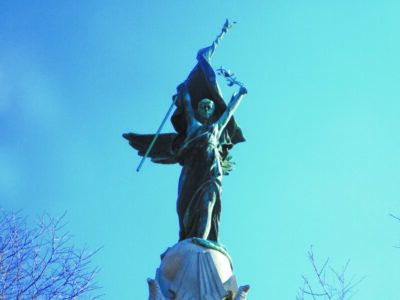
Another is the Brigadier General Harrison Thyng Memorial. Thyng, who was born in a one-room schoolhouse in Pittsfield, became one of the five flying ACEs to serve in both World War II and the Korean War before becoming a Brigadier General.
Bailey said that she and her daughter were stunned when they came upon the memorial. She said that it seemed to pop out of nowhere.
“But this is fascinating because you’re going down this dusty back road in Pittsfield,” said Bailey. “There’s nothing there but auto repair shops and little frame houses, and then you come upon this and it’s something that looks like it belongs on the National Mall.”
Bailey said that New Hampshire has a way of remembering its sons and daughters, no matter how long they stayed here. While some memorials are dedicated to soldiers like the Five Guardsmen, a group of five young men in the National Guard who were all from Manchester’s West Side and who were all killed on the same day, some honor people who only lived in New Hampshire for a short part of their lives.
“New Hampshire loves its veterans and takes care of its own,” Bailey said. “Jed Barker did not live in Franklin since he was 6 years old. And the town still put up a plaque for him. He died in Vietnam. New Hampshire loves long and hard.”
Barker was a marine who was killed while suppressing explosives during the Vietnam war, and he saved a fellow soldier’s life.
Bailey said that one of the things she noticed the most during her research was that more modern memorials are less slabs of granite and statues and more places, like gymnasiums, or fundraiser events people can participate in.
“The other thing we noticed was not only did the complexion and design of the monuments change, but starting at the tail end of Vietnam, people started honoring their war dead in more creative ways,” Bailey said. Many people have now chosen to do charity fundraisers, like golf events, or to have recreation centers or town pools named after them.
Bailey said that this only changes the way society recognizes people who fought in wars. Instead of having just monuments memorializing the dead, there are places remembering the sacrifice of those who survived as well.
War Monuments
All the following monuments and memorials, as well as longer descriptions of them, can be found in local historian Kathleen Bailey’s book New Hampshire War Monuments: The Stories Behind the Stones
Amoskeag Bridge
Amoskeag Brg, Manchester
This bridge is dedicated to all New Hampshire soldiers who died in Vietnam, including the five National Guardsmen from Manchester who were all killed the same day.
Brigadier General Harrison Thyng Memorial
Next to Floral Park Cemetery, 30 Barnstead Road, Pittsfield
The monument recognizes one of the few flying ACEs from both World War II and the Korean War.
Derrick Oxford Gravesite
Coreyville Cemetery, Plainfield
Originally, Oxford’s grave was marked with a plain stone. The Plainfield Historical Society found his grave and erected a gravestone with his name.
Jedh C. Barker Memorial Monument
Across from Franklin High School, 115 Central St., Franklin
This monument was erected in 2022, more than 50 years after Barker’s death because Barker is the only Medal of Honor recipient from Franklin.
Merci Train Boxcar
136 Reed St., Manchester
This memorial was given to Manchester by France to honor all the soldiers from New Hampshire who died in France during World War II.
World War I Monument
Victory Park, 91-139 Concord St., Manchester
The monument symbolizes the loss and mourning felt after the first World War.
A grassy oasis
Southern New Hampshire’s smallest city parks
By Matt Ingersoll
There is so much to discover in local parks — even the smallest ones that serve as grassy oases within major New Hampshire cities and towns. Some offer sweeping waterfront views or adequate tree shade perfect for a picnic, while others are home to statues honoring prominent figures in local history. No matter its size, every one of these mini parks has a story to tell.
“We are incredibly fortunate … to have such an extensive and diverse network of parks,” Mark Gomez, Chief of the Parks, Recreation & Cemetery Division for the City of Manchester, said in an email. “In an urban environment, the benefits of parks to both physical and mental health cannot be overstated.”
Nearly half of all 47 of the Queen City’s parks are under 5 acres in area — of these, several can be found within walking distance of the bustle of downtown. Many offer a wide array of amenities and are popular destinations for all kinds of community events and gatherings.
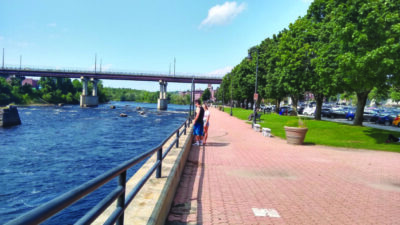
Arms Park, for instance, offers a mostly tree-lined walk along the waters of the Merrimack River, which directly faces to the west. It’s also known for being home to “Baer Square,” featuring a memorial statue and bench of Ralph Baer, a longtime Manchester resident widely considered to be “the father of video games.”
Wagner Park, which encompasses the block between Maple, Oak, Prospect and Myrtle streets, is also commonly referred to as “Pretty Park” due to its lush setting. It’s easily identifiable by a Greek-style temple monument in one of the park’s northern corners.
At the intersection of Hanover and Beech streets is Bronstein Park. Its features include an open grassy area, a scattering of trees and plenty of benches lining the sides.
“Bronstein Park … also has a bike FixIt station, which is pretty cool,” parks project manager Kate Waldo said. “We partnered with the Queen City Bike Collective, so if you’re riding your bike through town and you go through that park, [the FixIt station] has little attached tools to it that you can use to make repairs right there. So that’s a really cool, unique element you’ll see.”
According to Waldo, every feature of even the smallest park is maintained, from grass that’s mowed and trees that are pruned on a regular basis to benches and stone tables that are monitored for repairs. Other maintenance needs are commonly addressed, like trash receptacles to maintain a park’s cleanliness and light posts to improve its safety.
In Concord, there are a total of 21 parks and the vast majority of them are within a 10-minute walk of a residential area, said David Gill, the city’s Parks and Recreation director. Small parks like Bicentennial Square and Eagle Square, for instance, are located directly in the hub of downtown Concord’s business district and feature uniquely placed picnic areas and fountains. Fletcher-Murphy Park, which is adjacent to the Concord Community Music School, has its own open area facing the building where visitors can enjoy outdoor concerts and other events.
“Although they do not have the [visibility] or high use like … White Park or Keach Park, they are still very important as they provide space for the community to gather, relax and have fun,” Gill said of some of the Capital City’s smaller parks.
Downtown Nashua is similarly known for having several mini parks within walking distance of its center. Among them is a memorial known as Le Parc De Notre Renaissance Française, which was dedicated in May 2001 by the City to its French Heritage Committee. It has the distinction of being both the first full figure erected in the Gate City in a century and the first sculpture in New England to honor Franco-American culture.
Mini parks
Here’s a list of where you can check out some of southern New Hampshire’s smallest parks within major city and town limits. Features include everything from commemorative statues to playgrounds, picnic tables and benches, gazebos, basketball courts and more. Sources: bedfordnh.myrec.com, concordnh.gov, derrynh.org, manchesternh.gov, milford.nh.gov and nashuanh.gov
Bedford
Muller Park North Amherst Road
This park features just over 3 acres of conservation land that’s great for hiking, picnicking, and various scouting and camping activities.
Waterfowl Park Beech Street
Waterfowl Park features a scenic area with a ¼-mile walking trail located off Beech Street. The site is ideal for walking, hiking and bird-watching.
Concord
Bicentennial Square 1 Odd Fellows Ave.
This park is located in the hub of downtown Concord’s business district, with uniquely placed picnic areas, a fountain and electrical access.
Eagle Square 3 Eagle Square
Just below the historic Clock Tower on Main Street in downtown Concord, Eagle Square is a great place to enjoy a local concert, a stroll or an afternoon lunch break. Like in the Capital City’s Bicentennial Square, there are picnic areas and electrical access.
Fletcher-Murphy Park 28 Fayette St.
Directly adjacent to the Concord Community Music School, this park is known for its open area facing the building where you can enjoy outside concerts. It also features a basketball court and a playground.
Kiwanis Waterfront Park 15 Loudon Road
Behind the Douglas N. Everett Arena is Kiwanis Waterfront Park, situated on the banks of the Merrimack River. It’s a perfect area for a shady riverside picnic, and Concord’s local skateboard park is also located there.
McKee Square 8 Broadway St.
McKee Square is a small triangle-shaped park found at the intersection of Broadway, South and West streets. It’s easily identifiable by its gazebo in the center.
Reed Park 105 Hall St.
Named after the Concord-born Corp. Robert Wellington Reed, this park is nestled just below Interstate 93, featuring a softball field and playground. It’s also the site of youth and adult flag football leagues in the fall.
Riverside Park Tanner Street
Overlooking the Contoocook River in Concord’s Penacook neighborhood, Riverside Park is a great place for picnics due to its shady setting.
Derry
Hood Park 4 Rollins St.
Located within walking distance of Broadway in downtown Derry, Hood Park features amenities like basketball courtes, outdoor floor hockey and shuffleboards and a waterfront area.
MacGregor Park East Broadway
Directly adjacent to the Derry Public Library on East Broadway, MacGregor Park is known for hosting several special events throughout the year, like the town’s summer concert series, Memorial Day observances and Derryfest.
Manchester
Arms Park Between the Merrimack River and Commercial Street
This tree-lined riverside park features scenic views of the waters of the Merrimack River to the west. It’s also known for being home to “Baer Square,” featuring a memorial statue and bench of Ralph Baer, a longtime Manchester resident widely considered to be “the father of video games.”
Bass Island Park Second Street, between West Hancock and Cleveland streets
Located on the Piscataquog River on Manchester’s West Side, Bass Island Park is a peaceful park within a congested area of the city, with a vessel boat ramp and granite stones that provide access to the river’s edge.
Bronstein Park Hanover and Beech streets
This park is named after Ben Richard Bronstein, who was the first man from New Hampshire to die during World War II. The park is within walking distance of Manchester Central High School, with an open grassy area, a bicycle FixIt station, a scattering of trees and plenty of benches lining the sides.
City Hall Plaza, Manchester Elm Street, adjacent to City Hall
Manchester’s City Hall Plaza features several park benches and tables just outside the City Hall building on Elm Street.
Harriman Park Corner of Lake Avenue and Hall Street to the corner of Hall and Central streets
Originally named East Side Park, this park was renamed in 1922 in honor of Lt. Lynn H. Harriman, who served in the 101st Infantry in World War I. The park includes a memorial, a playground and a basketball court.
Kalivas Park Lake Avenue, Spruce Street and Chestnut Street
Located directly behind Manchester’s SNHU Arena, this park is named after Christos N. Kalivas, the first Greek-American from Manchester to be killed in action during World War I. A monument and plaque honoring Kalivas faces the park’s center.
Lafayette Park Notre Dame Avenue
At just over 2 acres on Manchester’s West Side, this park features a statue of Ferdinand Gagnon, widely considered to be “the father of Franco-American journalism.” The park was dedicated by the Franco-American Memorial Commission in 1957.
Martineau Park Montcalm Street and Dionne Drive
Martineau Park is a small triangle of land spanning less than a third of an acre between Montcalm Street and Dionne Drive on Manchester’s West Side. It’s named after Albert R. Martineau of Manchester, who served in the Army during World War II. It features benches, a cobblestone walkway and some tree-shaded grass.
Oak Park Oak and Maple streets
Accessed from Oak, Maple, Brook or Harrison streets, this park features several benches in a mostly tree-covered setting.
Pulaski Park Bridge and Pine streets
Named for Casimir Pulaski, a Polish immigrant who served in the Revolutionary War as a general and one of George Washington’s right-hand men, Pulaski Park has his statue in the center and is surrounded by lush grass fields as well as a basketball court.
Sweeney Park South Main Street
Sweeney Park is named after Private Henry John Sweeney, the first soldier from Manchester to die during World War I. Amenities include a memorial, a children’s playground and a basketball court.
Veterans Memorial Park Elm Street, between Central and Merrimack streets
Veterans Memorial Park is a popular destination for outdoor concerts and festivals, featuring a large covered stage that’s generally open from the spring through the early fall. In 2009, a World War II monument was erected inside the park.
Victory Park Between Concord and Amherst, Pine and Chestnut streets
This park is dedicated to Private First Class Rene A. Gagnon, who fought on Iwo Jima as a member of the Marine Corps. It’s a popular destination for family events throughout the summer months, courtesy of the Manchester City Library.
Wagner Park Maple, Oak, Prospect and Myrtle streets
In 1944, a woman named Ottilie Wagner Hosser granted the entire city block where her house stood to the city to be used as a park. It was modeled after a small park in Paris across from the League of Nations that she loved to visit. Amenities include park benches, a gazebo and a Greek-style temple that stands in the park’s northern corner and serves as the centerpiece.
Milford
Emerson Park 6 Mont Vernon St.
The parcels of land that today make Emerson Park were donated to the Town of Milford in 1947. The park is uniquely adjacent to the Souhegan River, just off the Milford Oval, and is the site of Milford’s widely attended summer concert series, which takes place every Wednesday night from 7 to 8:30 p.m., from early July to late August.
Kaley Park 448 Nashua St.
Like Emerson Park, Kaley Park’s location is directly adjacent to Milford’s Souhegan River. Its amenities include two multi-purpose playing fields, a softball diamond, a canoe launch and a conservation area.
Keyes Memorial Park 45 Elm St.
This park was originally farmland that was owned by members of the Crosby family. It was sold in 1957 to the Arthur L. Keyes Memorial Trust, which then gave the land to the Milford School District for athletics fields and a playground. A public swimming pool was added in 1965, followed by tennis courts in 1974.
Nashua
Deschenes Oval Main Street
Named after Amedee Deschenes, who served in World War I, this park is located in the heart of downtown Nashua, commemorating several war heroes from New Hampshire who gave their lives.
Le Parc De Notre Renaissance Française Water Street
This Water Street park, which overlooks the Nashua River, commemorates local Franco-American immigrants. Dedicated in May 2001 by the City of Nashua to its French Heritage Committee, the featured sculpture is both the first full figure erected in the Gate City in a century and the first sculpture in New England to honor Franco-American culture.
Natural treasures
What land trusts are and where to check them out
By Hannah Turtle
When it comes to finding natural treasures in and around the local community, the role of a land trust is paramount. Land trusts are often nonprofit organizations with the goal of aiding in land conservation.
“We’re all about conserving special places,” said Liz Short, executive director of Five Rivers Conservation Trust, based in Concord. “It really boils down to sustaining the ecological, social and community benefits that nature provides.”

Five Rivers, like many of the other land trusts in the area, focuses on helping community members protect their land through various conservation efforts. Through those efforts, the land often becomes a place that’s open for hiking and recreation, with a whole variety of natural landscapes to explore. Land trusts also play a role in engaging and protecting the community at large.
“Our mission at our core is land conservation, but we try to do that in a way that’s respectful of the need for housing, because it’s all part of a really important network,” Short said. “It’s what goes into making New Hampshire a great place to live, work and play.”
This goal is in part what drives the community events offered by land trusts in the area. Five Rivers, for instance, is hosting a free evening yoga class outdoors on Wednesday, Sept. 21, at Dimond Hill Farm in Concord. Piscataquog Land Conservancy, another trust in the local area, hosts the Rose Mountain Rumble, a non-timed gravel bike ride, on Saturday, Aug. 27, which will begin at Center Hall in Lyndeborough. Details on these events are available on the land trust websites, and more opportunities are available through the New Hampshire Land Trust Coalition’s website.
While land trusts endeavor to serve the community, there are also a multitude of ways for the community to get involved in land conservation.
“We have a lot of volunteer opportunities,” Short said. “Every year, we have volunteers help us with our annual monitoring of conserved lands.”
Five Rivers sends volunteers to all their protected lands to check on the conservation efforts, walk the grounds and take pictures.
“We offer training for that, so it’s really great for someone interested in learning more about conservation, and someone who wants to get out into the woods and learn to use a map and compass,” Short said. “We’re also always looking for new ideas on how to engage new members of the community … We really want to listen to what folks in this region care about, and how we can work to create more recreational opportunities and provide more access. A great way to help out and get involved is to join that conversation.”
Local land trusts with public access hiking trails and recreation
Here are some local land trusts with opportunities to check out hiking trails, parks and more. To find a land trust near you, visit nhltc.org.
Bear-Paw Regional Greenways
Deerfield, bear-paw.org
• Burbank Woods Preserve: 25-75 Coffeetown Road, Deerfield
• Great Marsh Preserve: Old Chester Turnpike, Hooksett
• North River Preserve: 128 Stage Road, Nottingham
Five Rivers Conservation Trust
Concord, 5rct.org
• Chichester Town Forest: 130 Hutchinson Road, Chichester
• Dimond Hill Farm: 314 Hopkinton Road, Concord
• Marjory Swope Park: Long Pond Road, Concord
• Winant Park: 11 Fisk Road, Concord
Piscataquog Land Conservancy
New Boston, plcnh.org
• Benedictine Park: 333 Wallace Road, Bedford
• Educational Farm at Joppa Hill: 174 Joppa Hill Road, Bedford
• Ferrin Pond Nature Preserve: Ferrin Pond Road, Weare
• Florence M. Tarr Wildlife Sanctuary: 83 Joppa Hill Road, Bedford
• Tuthill Woodlands Preserve: Tucker Mill Road, New Boston
Featured photo: Ralph Baer statue and memorial at Arms Park in Manchester. Baer, a longtime Manchester resident, is widely considered to be “the father of video games.” Photo courtesy of the City Of Manchester’s Parks and Recreation Division.

